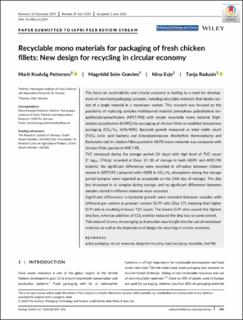| dc.contributor.author | Pettersen, Marit Kvalvåg | |
| dc.contributor.author | Grøvlen, Magnhild Seim | |
| dc.contributor.author | Evje, Nina | |
| dc.contributor.author | Radusin, Tanja | |
| dc.date.accessioned | 2020-11-13T10:05:04Z | |
| dc.date.available | 2020-11-13T10:05:04Z | |
| dc.date.created | 2020-07-27T09:34:36Z | |
| dc.date.issued | 2020 | |
| dc.identifier.citation | Packaging technology & science. 2020, 33 485-498. | |
| dc.identifier.issn | 0894-3214 | |
| dc.identifier.uri | https://hdl.handle.net/11250/2687744 | |
| dc.description.abstract | The focus on sustainability and circular economy is leading to a need for development of new food packaging concepts, including recyclable materials that ideally consist of a single material in a monolayer system. This research was focused on the possibility of replacing complex multilayered material [amorphous polyethylene terephthalate/ polyethylene (APET/PE)] with simple recyclable mono material [highdensity polyethylene (HDPE)] for packaging of chicken fillets in modified atmosphere packaging (CO2/N2: 60%/40%). Bacterial growth measured as total viable count (TVC), lactic acid bacteria and Enterobacteriaceae, Brochothrix thermosphacta and Escherichia coli for chicken fillets packed in HDPE mono materials was compared with chicken fillets packed in APET/PE. TVC increased during the storage period (24 days) with high level of TVC count (7 log10 CFU/g) recorded at Days 19–20 of storage in both HDPE and APET/PE material. No significant differences were recorded in off-odour between chicken stored in APET/PE compared with HDPE in CO2/N2 atmosphere during the storage period (samples were regarded as acceptable on the 24th day of storage). The drip loss increased in all samples during storage, and no significant differences between samples stored in different materials were recorded. Significant differences in bacterial growth were recorded between samples with different gas volume to product volume (G/P) ratio (Day 17), implying that higher G/P ratio is resulting in lower TVC count. The lowest G/P ratio caused the highest drip loss, whereas addition of CO2 emitter reduced the drip loss to some extent. This research is very encouraging as it provides new insight into the use of monolayer materials as well as the importance of design for recycling in circular economy. | |
| dc.language.iso | eng | |
| dc.subject | Design for resirkulering | |
| dc.subject | Design for recycling | |
| dc.subject | Active packaging | |
| dc.subject | Active packaging | |
| dc.subject | Cirkular economy | |
| dc.subject | Cirkular economy | |
| dc.title | Recyclable mono materials for packaging of fresh chicken fillets: New design for recycling in circular economy | |
| dc.type | Peer reviewed | |
| dc.type | Journal article | |
| dc.description.version | publishedVersion | |
| dc.source.pagenumber | 485-498 | |
| dc.source.volume | 33 | |
| dc.source.journal | Packaging technology & science | |
| dc.identifier.doi | 10.1002/pts.2527 | |
| dc.identifier.cristin | 1820541 | |
| dc.relation.project | Nofima AS: 201704 | |
| dc.relation.project | Norges forskningsråd: 262306 | |
| dc.relation.project | Norges forskningsråd: 267648 | |
| dc.relation.project | Nofima AS: 11970 | |
| cristin.ispublished | true | |
| cristin.fulltext | original | |
| cristin.qualitycode | 1 | |
